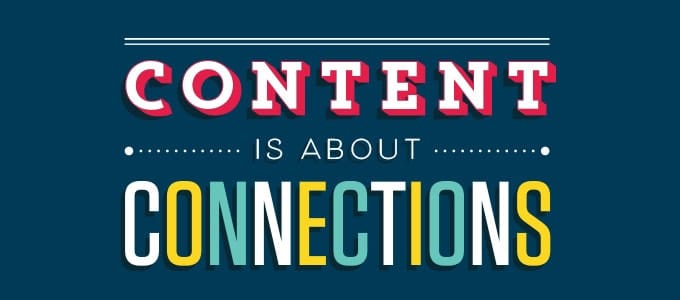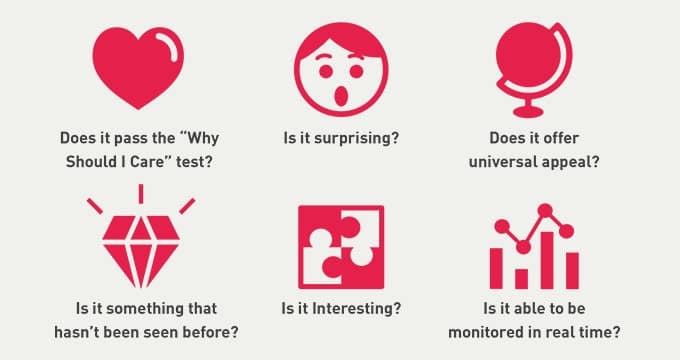Content is About Connections

This is not a how-to guide. There is no magical formula for creating content that is valuable, shareable, or any other of the various “-ables.” There is no foolproof strategy for successful content marketing — and don’t let the 165 million search results for “how to create content for brands that always works” tell you otherwise.
The truth is, there are only suggestions, and the success of any brand’s content efforts depends largely on how much they understand about their audience. Engaging content connects with the audience on a personal level, and that connection can only be made if the content is genuinely interesting to them, or otherwise fulfills some need. If that sounds super obvious, it’s because it is — but it’s also obvious that the vast majority of brands don’t get it. (Source: every forced meme on Facebook ever.)
The good news is there are fundamental truths that can (and should) inform your content creation process. These techniques may not be infallible, but they’re a lot more useful than sorting through page after page of search results, only to find that you’ve been reading a bunch of pointless “listicles” for the past seven hours.
It’s Not You, It’s Them.
We’re drowning in information, and according to Sturgeon’s Law, 90 percent of it is crap. So don’t contribute to the barrage of bad content — your audience deserves better than click bait.
Before you even begin to consider creating content, you need to know what, where, when, and how your audience wants to consume it. Once you know all of those things, give it to them exactly the way they want it. Remember: It’s about them, not you. You have to be the source they need you to be, not the source you want to be for them.
AirBNB has done a fantastic job of understanding its audience. While they provide services to both the travelers seeking accommodations and the home and apartment owners looking to make some extra money, the traveler angle is where the majority of their content efforts have been focused — and rightly so. AirBNB’s neighborhood guides are a perfect example of content created to fit those travelers’ needs. They’re editorial, beautifully designed, and, most importantly, contain useful information that’s actually relevant to the audience. But perhaps even better than that is the fact that AirBNB isn’t actually trying to sell accommodations with these nice little guides. Are increased bookings a by-product? Probably. The point is, they understand who they’re talking to and what those people are looking for — and that sales can’t be the endgame of that conversation.
Location Matters
Content comes in all shapes and sizes, and the place it’s delivered is as important as the delivery itself. The fact that platforms like Facebook, Twitter and Tumblr exist doesn’t mean it makes sense for your brand to have a presence on all (or even any) of them. So, how do you determine whether you should be on a specific platform?
Ask yourself these questions:
- Is my brand’s audience on this platform?
- Is my brand’s audience engaging with other branded content on this platform?
- Are any of my brand’s competitors successfully using this platform?
- Does my brand have clear, measurable objectives for using this platform?
- Does my brand have the necessary resources and budget to sustain consistent, quality use of the platform?
Once you’ve identified where you want to have a presence, you then have to understand what forms of content are native to each platform. Take social media, for example. Facebook, Twitter, Instagram, and Pinterest have overlapping functions, but that definitely doesn’t mean their users value or are even attracted to the same things. If you’re going to create content for a specific platform, make sure it’s just that — specific to the platform. Again, this probably sounds super obvious, but one look at each of your social feeds should be enough to prove that few brands are consistently doing this well.

Question Everything
In a presentation at BlogWell San Francisco, Coca-Cola’s Manager of Digital Communications and Social Media shared the formula for the company’s content marketing success: a list of six questions to ask before releasing any content into the wild. These questions serve as a pressure test, allowing only the content that is relevant, consistent, and compelling to be released. More brands would do well to ask themselves these questions before rolling out content. After all, if it doesn’t serve a useful purpose, then it’s meaningless. At that point, it’s just content for the sake of content.

Conclusion
When it comes to content, the best thing a brand can offer is a genuine sense of understanding. Give your audience what they want. Give them what they ask for. Hell, give them what they didn’t even know they needed. Chances are, you’ve already created a product or service that satisfies some of their needs. Now it’s just a matter of taking the time to get to know them on a more personal level. Meaningful connections are not made through passive research. You wouldn’t expect to make friends with someone simply by reading up on what people in their general age group are interested in — so why should this be any different? Interact with and listen to your audience on a regular basis, and use what you learn to feed what you create. If you do it right, you’ll not only have a happy, thankful audience — you’ll have content that’s part of the golden 10 percent of non-crap, too!